Dyson was started in 1991 by James Dyson in the UK who originally brought the cyclonic vacuum technology or bagless vacuum cleaner to the mainstream. I personally have the Dyson Outsize Absolute and we are super happy with it.
Since then, Dyson has released several products, including the Dyson bladeless fan in 2009 and then their first air purifier in 2015. Air purifiers are just fans connected to filters. Hence, with indoor pollution becoming more and more of an issue around the world it makes total sense that Dyson would make the move into air purifier manufacturing.
This particular model that I am reviewing is the Dyson HP04 Hot + Cool, which is priced at $690*, not cheap when you compare it with other air purifiers on the market. But then again, no other devices offer fan cooling and heating.
In general, the technological improvements in the air purifier world relate to the filter types. Still, Dyson is bringing something very new with its bladeless fan, and I’m excited to see how this unit compares with other air purifiers.
As with all the air purifiers we review here at HouseFresh, we bought the Dyson HP04 Pure Hot + Cool with our own money to ensure we can share our unbiased opinion. We also performed a series of tests on this unit that allow us to compare it like for like against all the other air purifiers we have reviewed over the years.
Right, let’s get into it.
The lowdown on the Dyson HP04 Pure Hot + Cool

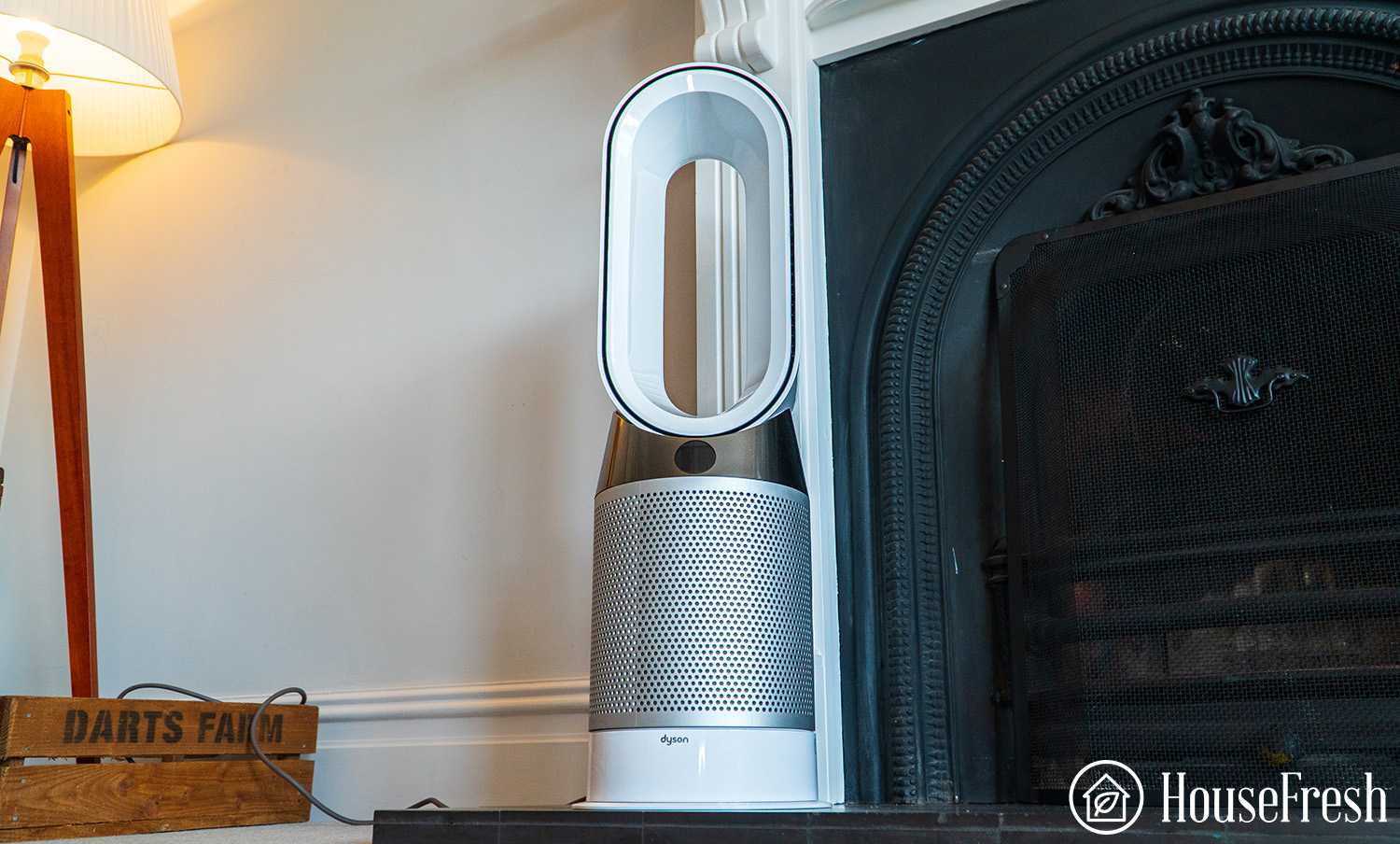
Let’s get down to the nitty-gritty. Here are the key points we found when reviewing the Dyson HP04.
What we really like
What we think could be better
The specifications
At $745, the Dyson HP04 doesn’t come cheap. For around this price, you could look to buy the Alen BreathSmart 75i with a CADR rating of 347 ($636.65) or the Mila Air Purifier with a CADR score of 263 CFM ($408). As the Dyson only scores a lowly 89 CFM, it’s fair to say that on paper, it doesn’t cut the mustard. But let’s see how it got on in our real-world review.
| HouseFresh rating: | ★★★☆☆ |
| Time to clean our 728 cubic feet test room (with the device running at top speed): | 1 hour and 24 minutes |
| Air purifier technology: | HEPA and activated carbon filter |
| Recommended room size (estimated by HouseFresh to achieve 4.8 air changes per hour): | 139 sq. ft. |
| Clean air delivery rate (CADR): | Estimated: 89 CFM |
| Dimensions (in inches / in cm): | 30.1H x 8.1W x 5.1D inches (76.5H x 20.7W x 13D cm) |
| Weight (in pounds / in kg): | 12.36 lbs (5.6 kg) |
| Filter life: | 12 months |
| Noise level in decibels (measured from 3 ft. away with a sound level meter): | Speed 1: 37.2 dB Speed 2: 43.5 dB Speed 3: 49.1 dB Speed 4: 54.6 dB |
| Electricity consumption in watts (recorded with an electricity usage monitor): | Standby mode: 0.5 watts Speed 1: 4.6 watts Speed 2: 9.1 watts Speed 3: 16.8 watts Speed 4: 25.5 watts |
| Estimated running cost (electricity consumption + official filter replacement): | $81.88 per year |
| Cost per CADR cfm (based on dust CFM as reported by AHAM): | $4.59 |
| Manufacturer’s warranty: | 2 years |
| Country of manufacture: | Malaysia |
Futuristic design fit for modern homes
Intuitive controls, high-tech features and smart capabilities
Air purifiers these days can come in all shapes and sizes, but for the most part, they are usually a box-type design that pulls in air from either the front and back or the sides. Dyson is known for their innovative designs, and the HP04 is no different.
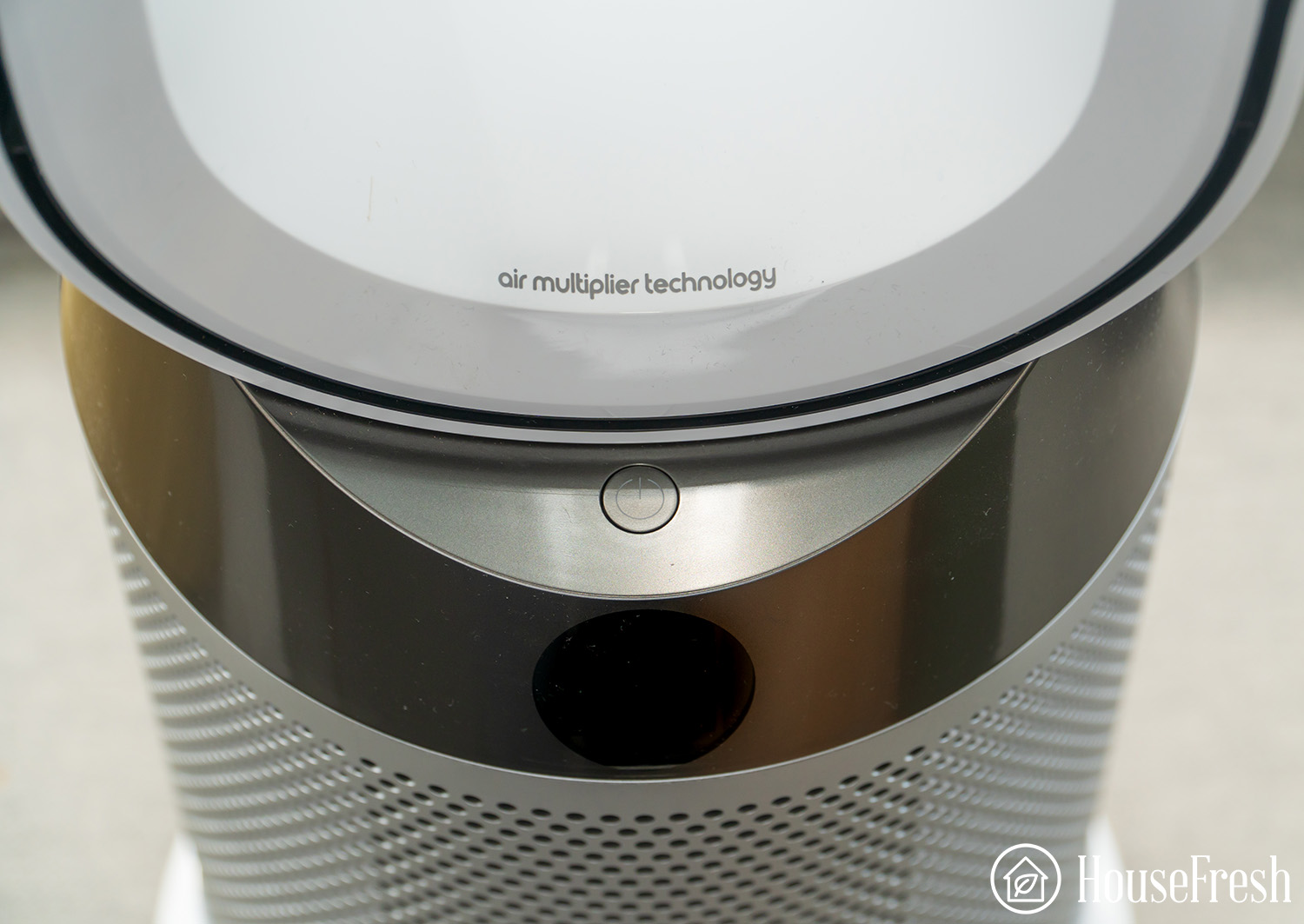
This has to be one of the best-looking air purifiers I have ever encountered. It would fit perfectly with the interior design of the modern home without taking up too much space as you would find with a box unit like the Coway Airmega 300.
The top half of this air purifier combo is the fan whilst the bottom section is where the filters sit. Simply put, it pulls air from the bottom through the two filters and then blows it out via the air outlets at the top.

The bladeless fan is great for homes with curious kids who like to put their fingers into anything (as mine tend to do) and whilst it’s tall, it doesn’t feel intrusive to the room.
When comparing the Dyson HP04 to the Smart Air S, you notice the contrast in design styles. Although the Smart Air S is still a cute-looking unit with its own charming features, the HP04 takes on a futuristic aesthetic that challenges the everyday design of household appliances.

As we’ve come to expect from Dyson products, the HP04 comes well-packaged in a branded box. There’s still a little too much plastic for my liking, but they’re getting better at reducing their carbon footprint with their packaging.
If you have used a Dyson before, you’ll know that they provide a great user experience; the same is true of the HP04.
It has a digital display on the front that tells you the quality of the air in the room and which fan speed it’s currently set to. Using the remote control, you have ten different speeds to use, allowing you to harmonize the unit with the air quality or temperature.

In older models, you could only use both functions simultaneously. If you wanted to clean the air, you would also have to put up with the fan cooling/heating the room. With the HP04 you can set the unit to purify the air and not use the fan, which is certainly useful for those living in colder climates.
The fan can turn at varying degrees from 90 to a maximum of 350 which I would use during the summer to get as much cool air around me as possible.
Auto mode allows the unit to only come on when it detects pollutants in the air and is a useful feature for those who have occasional issues with air pollutants like rush hour traffic on the adjacent road or dinner-time cooking odors.
The remote comes in its own box with the function of each button printed on it, making it so much easier to learn what each one does without spending time surveying the manual. However, you still do receive a physical manual with the unit. Like a lot of people now, I instantly lose any manual because I know everything I need is online. With a progressive company like Dyson, I expected them to not waste paper.
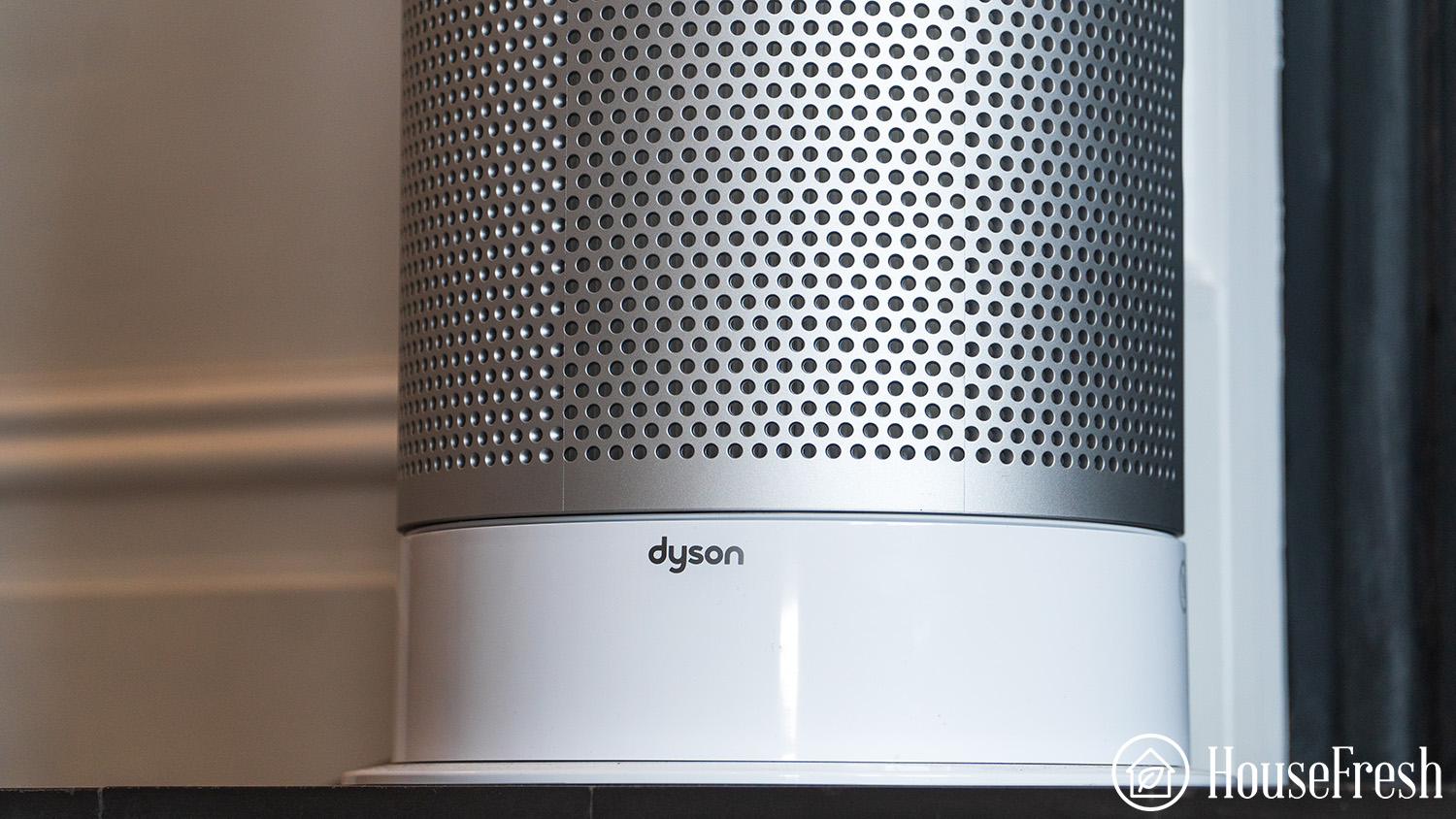
The remote is pretty small but very functional. You can control each function of the unit including fan speed, heating or cool mode, sleep timer, and the direction you want the air to flow. It even has a magnetic element so it can easily be stored on the top of the air purifier without it falling and being lost.
The next step is to set up the app which is super simple once you’ve downloaded it from the Android or Apple app store.
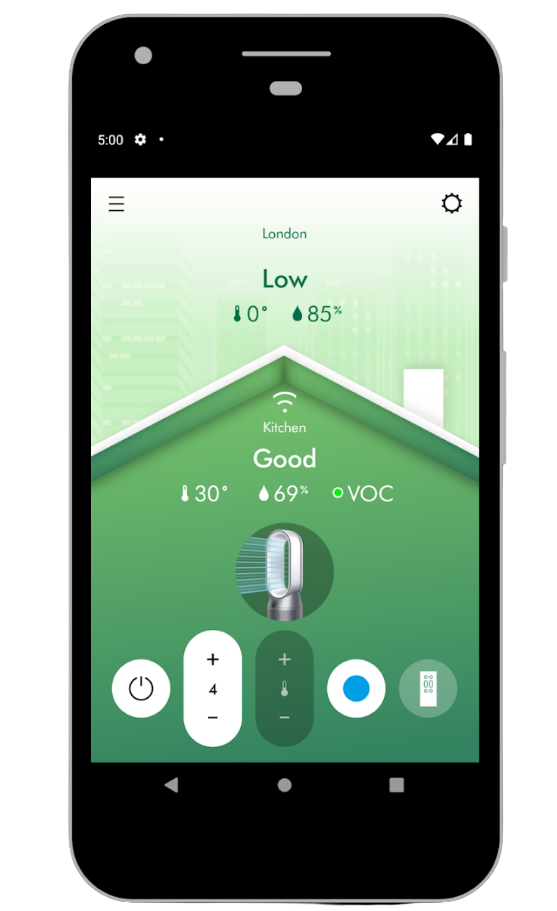
Not only can you control the unit’s functions, but you can also monitor the air quality of your room, the air quality outside, see your unit’s activity, and get reports on temperature, humidity, and filter life.
Once it’s set up you get a big tick and the air purifier is ready to work its magic.
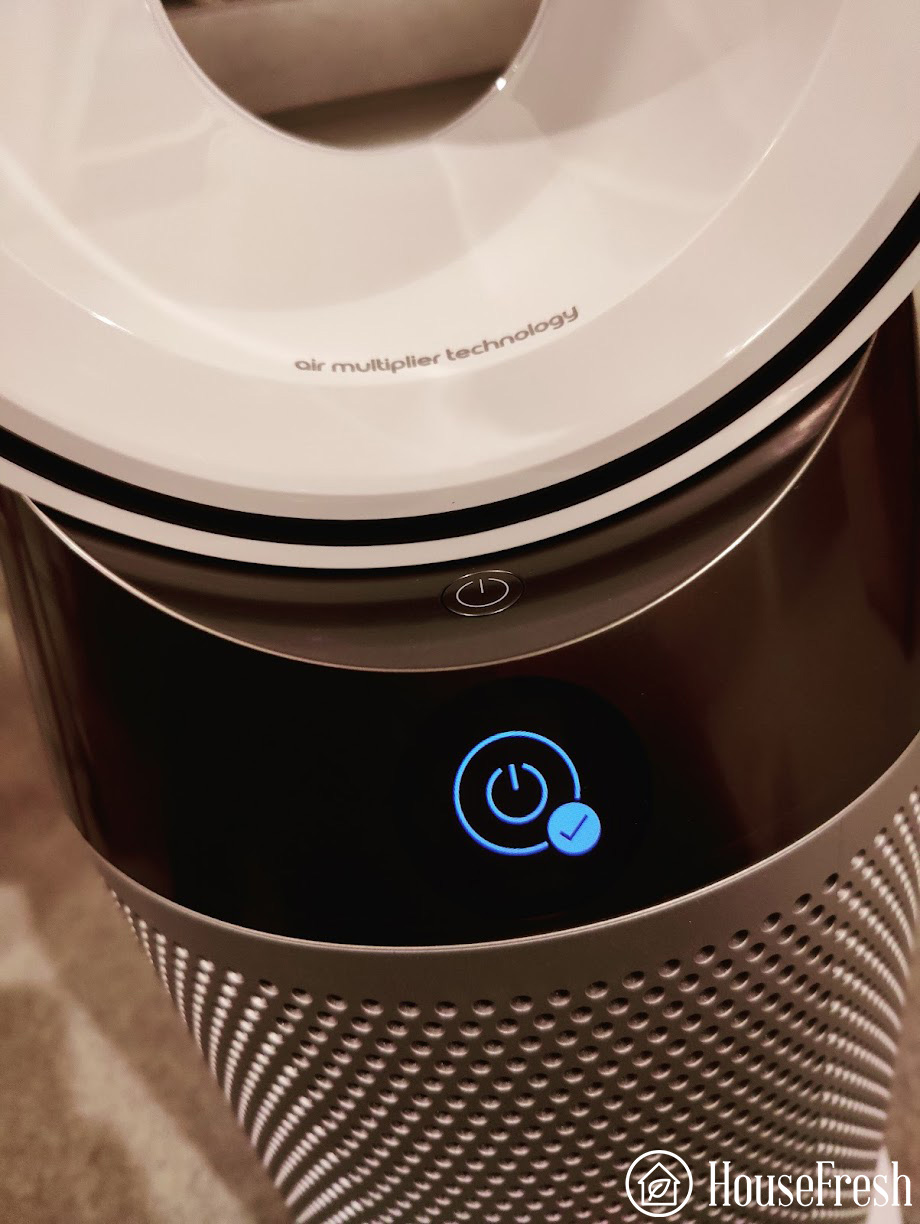
Small filters leave question marks over purifying capability
A round filter comprised of two separate halves that clip together in place, similar to other Dyson air purifiers
The one thing I was surprised about was the size of the filters. They are a lot smaller than I expected for such a big machine. This probably goes to explain why the CADR scores are so low when compared to other smaller units with bigger filters.
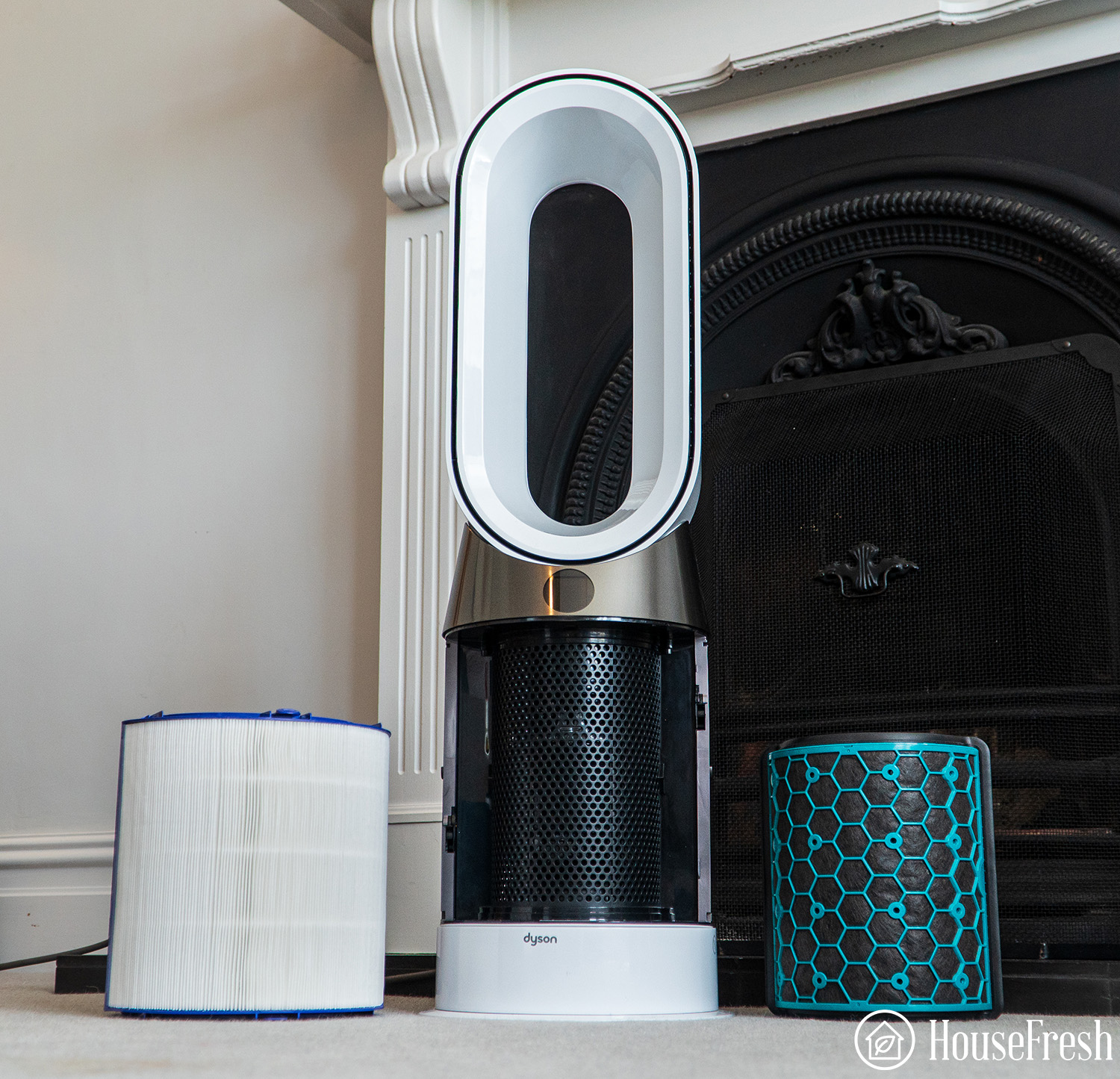
The activated carbon filters are fairly narrow, and I just can’t imagine that this amount of activated charcoal is going to be able to remove much beyond minor odors in small rooms. In comparison, the Austin Air Healthmate Pro comes with 15 lbs of activated carbon – this unit weighs 12.36 lbs in total.

A lot of new units come with a washable pre-filter. These act as the first line of defense as they are able to stop bigger particles before they hit the HEPA filter. Being washable prolongs the life of the other filters, saving you from having to replace them more often.
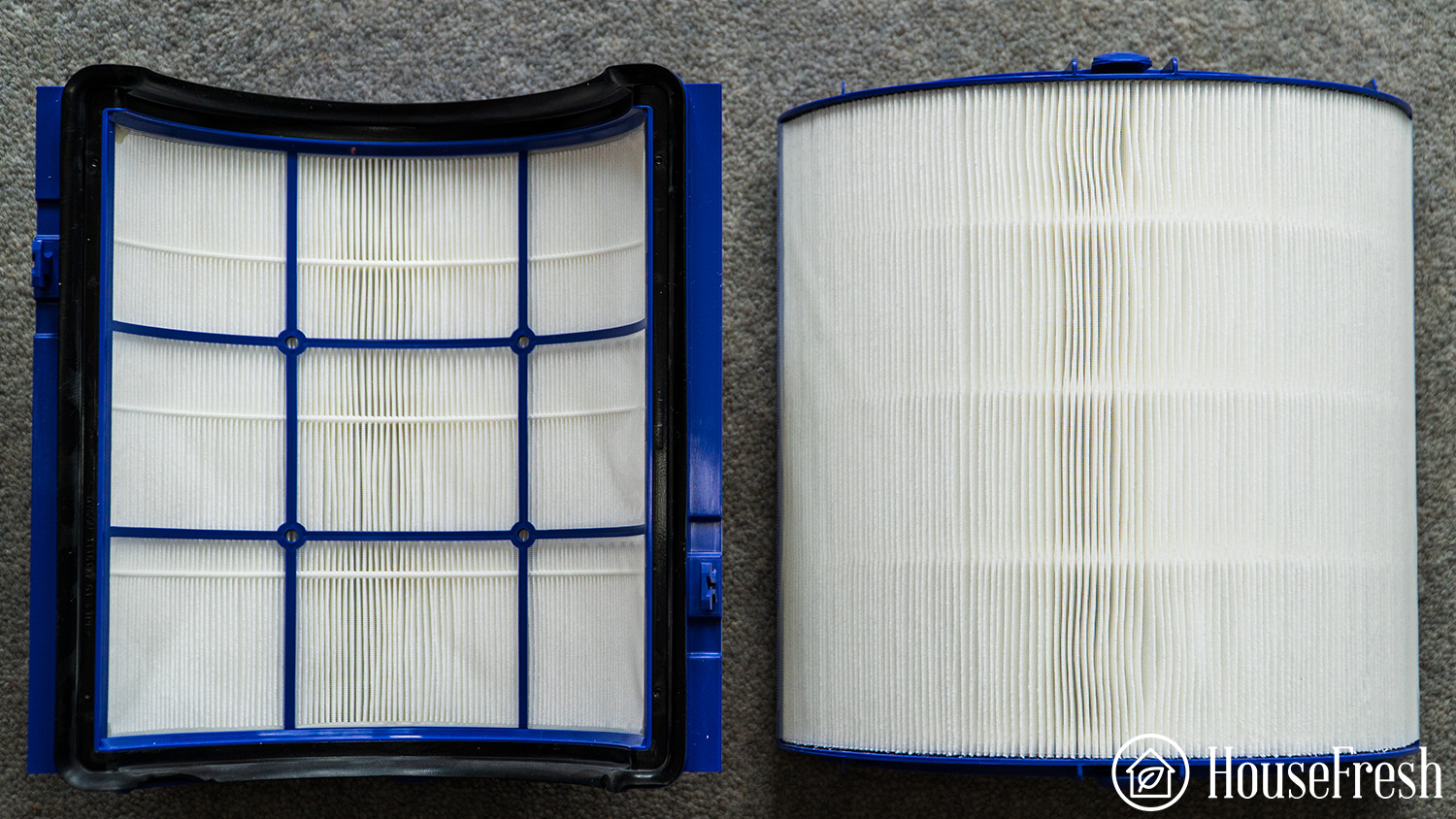
However, there is no pre-filter here, which is disappointing as you’ll notice decreased performance relatively soon once hair, lint, and fur start to clog up your HEPA.
When it comes to changing the filter, the first thing you need to do with this unit is take off the covers and attach the charcoal filters. There is a big warning sign on the unit so you’re not going to forget. The activated charcoal filters clip in easily and you can see that the seal is airtight thanks to the rubber elements around both filters.
The filters then clip into the unit in two halves. Once you’ve removed the outer panels of the purifier section of the unit, they fit in as two semi-circles that make up the 360-degree air intake.
The Dyson HP04 cleared our test room in 1 hour and 24 minutes
That’s 14 minutes longer than the Dyson PH03 and more than double the time than the Dyson Cool TP07
To test this unit I used our home office and generated smoke using an incense stick. I used the Purple Air Indoor Sensor to evaluate the change in air quality over time.
I wanted to know how quickly the Dyson HP04 could reduce the amount of PM2.5 and PM10 particles in the air. These tiny particles are the most important to remove as they can get deep into the lungs and cause long-term health issues.
The room was 728 cubic ft. I started the air purifier once 50% of the incense had burned, and my air quality sensor showed 500 PM10 and 500 PM2.5.
Similar to the team at IQAir, but for different reasons, the Dyson team are not big fans of CADR methods.
They argue that their fan air purifier can move more air around the room than standard air purifiers, so they use their own POLAR test.
Like any test, CADR has its limitations, but I still think it’s a good benchmark to allow consumers to compare units.
Unlike the US, China has strict rules around air purifiers, so Dyson does reveal the details for the slightly upgraded HP07 unit on their site in China.
A CADR of 151.m3/h equated to 88.9341 CFM for a unit costing $700 is not great, considering you can purchase a unit that is less than $100 that achieves a higher CADR of 140 with the Levoit Core 300.
Air cleaning performance compared
While this unit does have way more features than the Levoit 300 (such as a fan, heating element and a smartphone app), I still expected this unit to perform a lot better than the Levoit 300 during our tests.
Noise levels test results
A concern for many with air purifiers is the amount of sound generated. In our tests, it clocked up to 54.5 dB on its highest setting, which is fairly low when compared to other units. It even matches some SilentHEPA Blueair units, such as the Blue Pure 411.
But I know that sound can be very subjective, so I created a video to show the sound at each speed level from 1-10.
The cost to run a HP04 Pure Hot + Cool: $81.88 per year
1. Electricity costs = $38.89
The running costs of an air purifier are something you should always consider, both in the costs of electricity usage and the required amount of filter replacements.
This unit has a recorded power consumption of 36-44 watts, but when I tested it using a power meter, I found that on the maximum setting, it only pulled 25.5 watts.
| Speed setting | Wattage used |
| 1 | 3.5 |
| 2 | 3.8 |
| 3 | 4.6 |
| 4 | 5.2 |
| 5 | 6.5 |
| 6 | 9.1 |
| 7 | 11.7 |
| 8 | 16.8 |
| 9 | 20.2 |
| 10 | 25.5 |
Using the average energy prices as registered by the U.S. Bureau of Labor Statistics, we can see that at its highest setting, this air purifier will cost $38.89 a year if left to run 24/7, which is excellent efficiency for a larger unit.
When I used the heating element – the power wattage jumped significantly, with an average of 2500 watts which shows how energy-intensive space heaters are, so ensure you are aware of the incurred costs ($3.813 per year) if you’re planning to use the heater feature regularly.
2. Filter costs = $42.99
Replacing filters is another cost that many don’t think about. However, this can get costly, so it’s best to know what you’re committing yourself to.
The genuine HEPA and activated carbon filters are $65, which is above average for a unit with this level of performance. There are also generic filters available on Amazon for $42.99 which may not perform as well as the original Dyson filters, but it’s good to know that there are cheaper options out there.
Dyson recommends you replace the filters every 12 months, but based on their size and lack of pre-filter, I would expect this to be more like 6 months. We will keep an eye on this as we use it over the long term and report back on how long they lasted.
- 【Less Cost】 H13 True HEPA filter which fits and works as good as the original but cost by half.
- 【Breath Clean Air】 Great for pet owners or people sensitive to the air. Our filters are capable of filtering the smoke produced by wildfires, rendering the indoor air pure and delightful.
- 【Effortless Setup】 Just take the original filter out, and fit the new one in.
- 【Fit Perfectly】 Compatible with Dyson HP04, TP04 and DP04 Air Purifier and Tower Fan, TP05 and DP05 models. All manufacturers' names and part numbers are used for compatibility information only.
- 【Long Lasting】 It is recommended to replace filters for every 12 months. All manufacturers' names and part numbers are used for compatibility information only.
Bottom line
If you want an air purifier that works as a fan and a heater, then you don’t have any other options apart from the Dyson HP04.
I’m a big fan of the innovation that Dyson is bringing to the air purifier market. Still, its air cleaning performance has a long way to go before I would recommend this unit over getting a separate fan and a much cheaper air purifier.
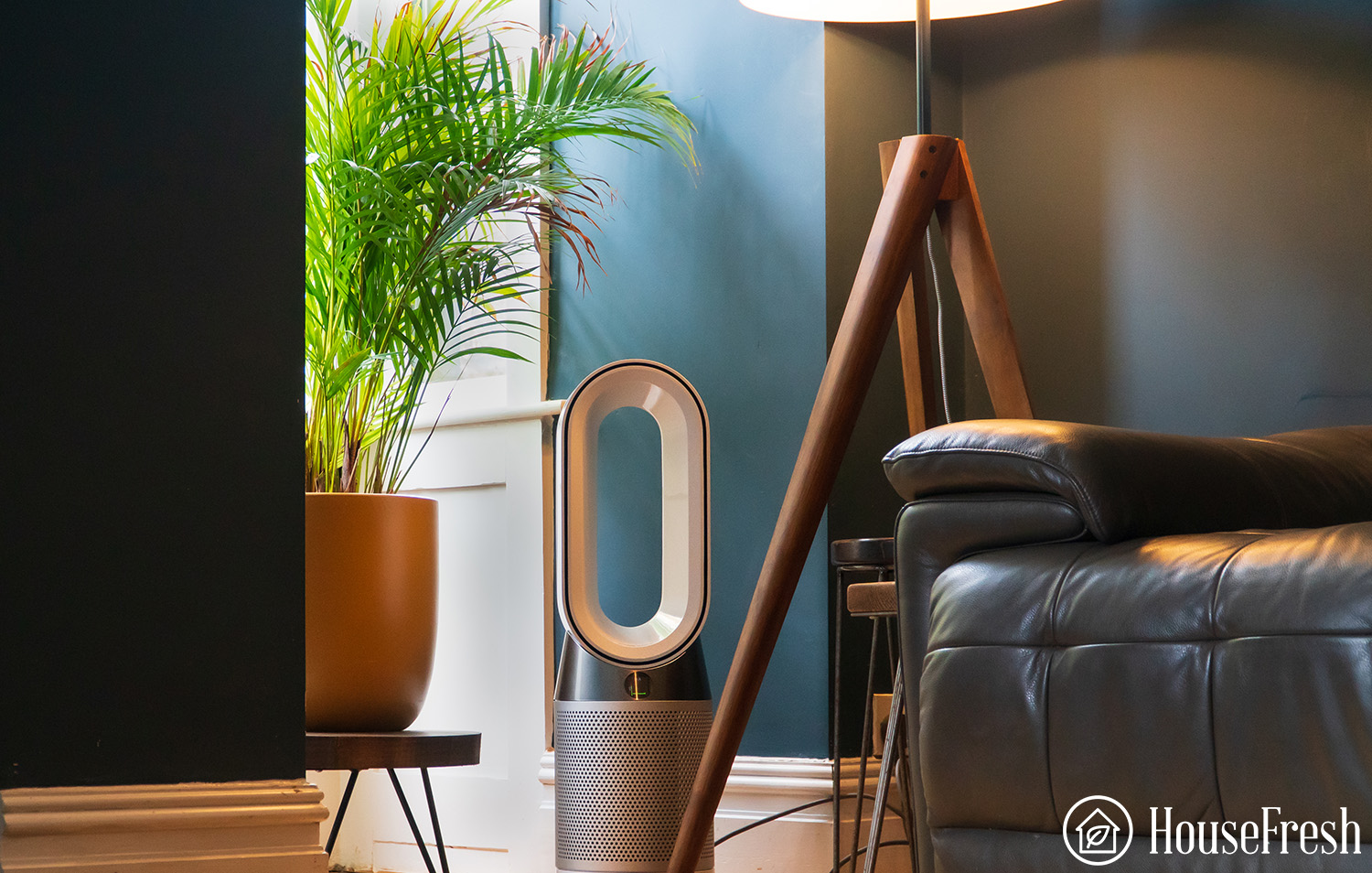
I dislike that they don’t make the CADR clear for consumers and hope that they update their marketing material to align with what they have for China.
It’s certainly a great-looking machine, and the auto-mode and app work as well as you would expect for a $700 unit. But, for those looking for the best bang for the buck for cleaning the air – there are far better options.
If you’re looking for a top-end unit, you’d be much better off going for the superior AlenBreathSmart 75i, the ‘godfather’ IQAir Healthpro Plus, or save yourself some cash and opt for the quickest purifier to undertake our real-world tests the Levoit Core 600S.
SOURCES
We calculated yearly costs associated with running the Dyson HP04 Pure Hot + Cool 24 hours a day, 365 days per year utilizing the latest average energy prices as reported by the Bureau of Labor Statistics of $0.174/kWh as of April 2024.




